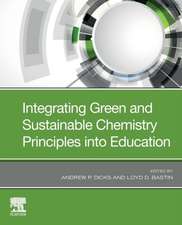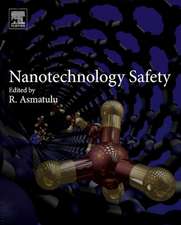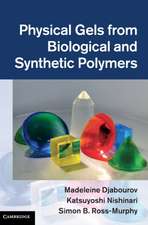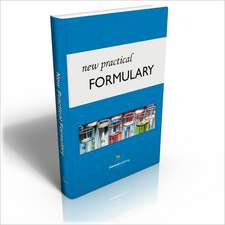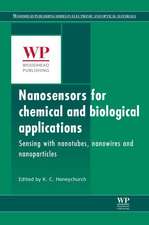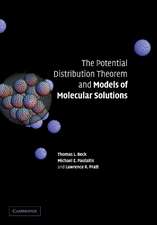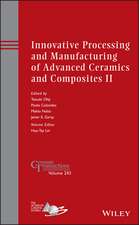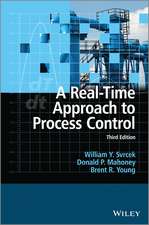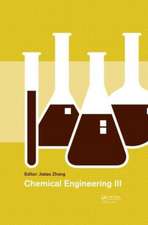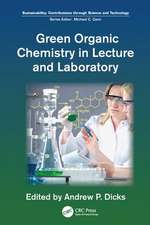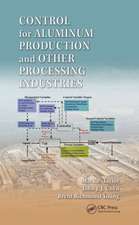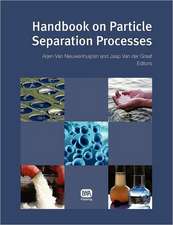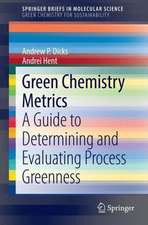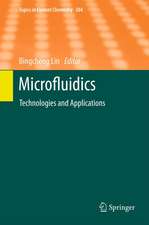Problem-Solving Exercises in Green and Sustainable Chemistry
Autor Albert S. Matlack, Andrew P. Dicksen Limba Engleză Paperback – 28 oct 2015
The problems described in this book are relevant and stimulating in learning and understanding the principles of green and sustainable chemistry. They address various aspects of the field, including:
- Toxicity
- Waste generation and disposal
- Chemical accidents
- Energy efficiency
- New policy development
This book also prompts students to become more comfortable with the idea of multiple "correct" answers to problems. It emphasizes the reality that green chemistry is about making practical decisions and weighing multiple factors that are often conflicting, thus making it difficult or impossible to apply one perfect solution to a given situation. Problem-Solving Exercises in Green and Sustainable Chemistry prepares students to solve challenging problems, whether as green chemists, as architects designing energy-efficient buildings, or as environmentally-conscious citizens.
Preț: 363.00 lei
Nou
Puncte Express: 545
Preț estimativ în valută:
69.47€ • 72.26$ • 57.35£
69.47€ • 72.26$ • 57.35£
Carte tipărită la comandă
Livrare economică 14-28 aprilie
Preluare comenzi: 021 569.72.76
Specificații
ISBN-13: 9781482252576
ISBN-10: 1482252570
Pagini: 195
Ilustrații: 45 black & white illustrations, 5 black & white tables
Dimensiuni: 156 x 234 x 13 mm
Greutate: 0.29 kg
Ediția:1
Editura: CRC Press
Colecția CRC Press
Locul publicării:Boca Raton, United States
ISBN-10: 1482252570
Pagini: 195
Ilustrații: 45 black & white illustrations, 5 black & white tables
Dimensiuni: 156 x 234 x 13 mm
Greutate: 0.29 kg
Ediția:1
Editura: CRC Press
Colecția CRC Press
Locul publicării:Boca Raton, United States
Cuprins
Foreword by John C. WarnerIntroduction by Professor Hal WhiteToxicity, Accidents, and Chemical WasteGeneral BackgroundToxicity of Chemicals in the EnvironmentAccidents with ChemicalsWaste and Its MinimizationConclusionsProblemsReferencesThe Chemistry of Longer WearWhy Things Wear OutStabilizers for PolymersLubrication, Wear, and Related SubjectsInhibition of CorrosionMendingThe FutureProblemsReferencesThe Chemistry of Waste Management and RecyclingWasteRecyclingMethods and Incentives for Source ReductionOverall PictureProblemsReferencesEnergy and the EnvironmentEnergy-Related ProblemsHeating, Cooling, and Lighting BuildingsRenewable Energy for Electricity and TransportUse of Less Common Forms of Energy for Chemical ReactionsProblemsReferencesEnvironmental EconomicsIntroductionNature's ServicesEnvironment AccountingCorporationsEnvironmental Economics of IndividualsGovernment Actions Affecting Environmental EconomicsProblemsReferencesThe Greening of SocietyIntroductionIndividualsGovernmentBusinessesProblemsReferencesSolutions to In-Chapter ProblemsSolutions to Chapter 1Solutions to Chapter 2Solutions to Chapter 3Solutions to Chapter 4Solutions to Chapter 5Solutions to Chapter 6References
Recenzii
'"Problem-Solving Exercises in Green and Sustainable Chemistry", by Albert S. Matlack, edited by Andrew P. Dicks, is an excellent book which should be a part of the library of educators who teach the subject, and chemists in general. It is a showcase of problem-based learning, so-called PBL, in which students and other learners are fully engaged in learning via problem solving. Anybody who teaches is well-aware of extra time after the lecture is delivered, when one wishes to have some interesting problems to give to students to work on and discuss. This is a problem particularly in green and sustainable chemistry, which is a new field and not much educational material exists. The author has a gold mine of examples that he has developed over his teaching career, which, significantly, followed his long career in industry. Thus, his examples are rooted in reality, and are quite relevant. Also, they are examples of the evolving issues, rather than something that is solved and set in stone. Thus, these examples are excellent for promoting classroom discussion, and assigning problems to students to research them. General solutions for the problems and useful hints are given in the back of the book. Since the material was developed over a period of years, many references are outdated. However, this minor shortcoming of the book can be easily overcome, since the instructors can either update references themselves, or delegate this task to the students. In conclusion, this unique and valuable book is most highly recommended.'
– Vera M. Kolb, Professor of Chemistry Emeritus, University of Wisconsin-Parkside.
– Vera M. Kolb, Professor of Chemistry Emeritus, University of Wisconsin-Parkside.
Notă biografică
Albert S. Matlack began his career in chemistry with the Manhattan Project before spending 43 years at Hercules Incorporated in Wilmington, Delaware. After he was forced to retire at the age of 70, he volunteered to teach at the University of Delaware, stopping just months before his death at the age of 90 in 2013. He spent more than ten years writing the textbook Introduction to Green Chemistry and compiled the problems covered in Problem-Solving Exercises in Green and Sustainable Chemistry shortly before his death. He was passionately interested in all aspects of chemistry, and devoted his research to problems in the environment caused by chemicals. Andrew P. Dicks is a teaching faculty member at the University of Toronto. After undergraduate and graduate study in the United Kingdom, he became an organic chemistry sessional lecturer in 1999, and was hired as part of the university teaching-stream two years later. He has research interests in undergraduate laboratory instruction that involve designing novel and stimulating experiments, particularly those that showcase green chemistry principles. This work has led to over 45 peer-reviewed publications in the chemistry education literature. He has won several pedagogical awards and is the editor of the textbook Green Organic Chemistry in Lecture and Laboratory . In 2014 he was co-chair of the 23rd IUPAC International Conference on Chemistry Education. Following the passing of Albert S. Matlack, he assumed editorship of Problem-Solving Exercises in Green and Sustainable Chemistry in order to ensure the issues discussed in this book became available to the broader chemistry community.
Descriere
This book teaches students how to analyze and solve real-world problems that occur in green and sustainable chemistry. It describes situations based on events that have actually taken place and encourages creativity in finding solutions to problems that have multiple "correct" answers. The exercises and commentaries from the experienced author emphasize the reality that green chemistry is about making practical decisions and weighing multiple factors that are often conflicting, thus making it difficult or impossible to apply one perfect solution to a given problem.

